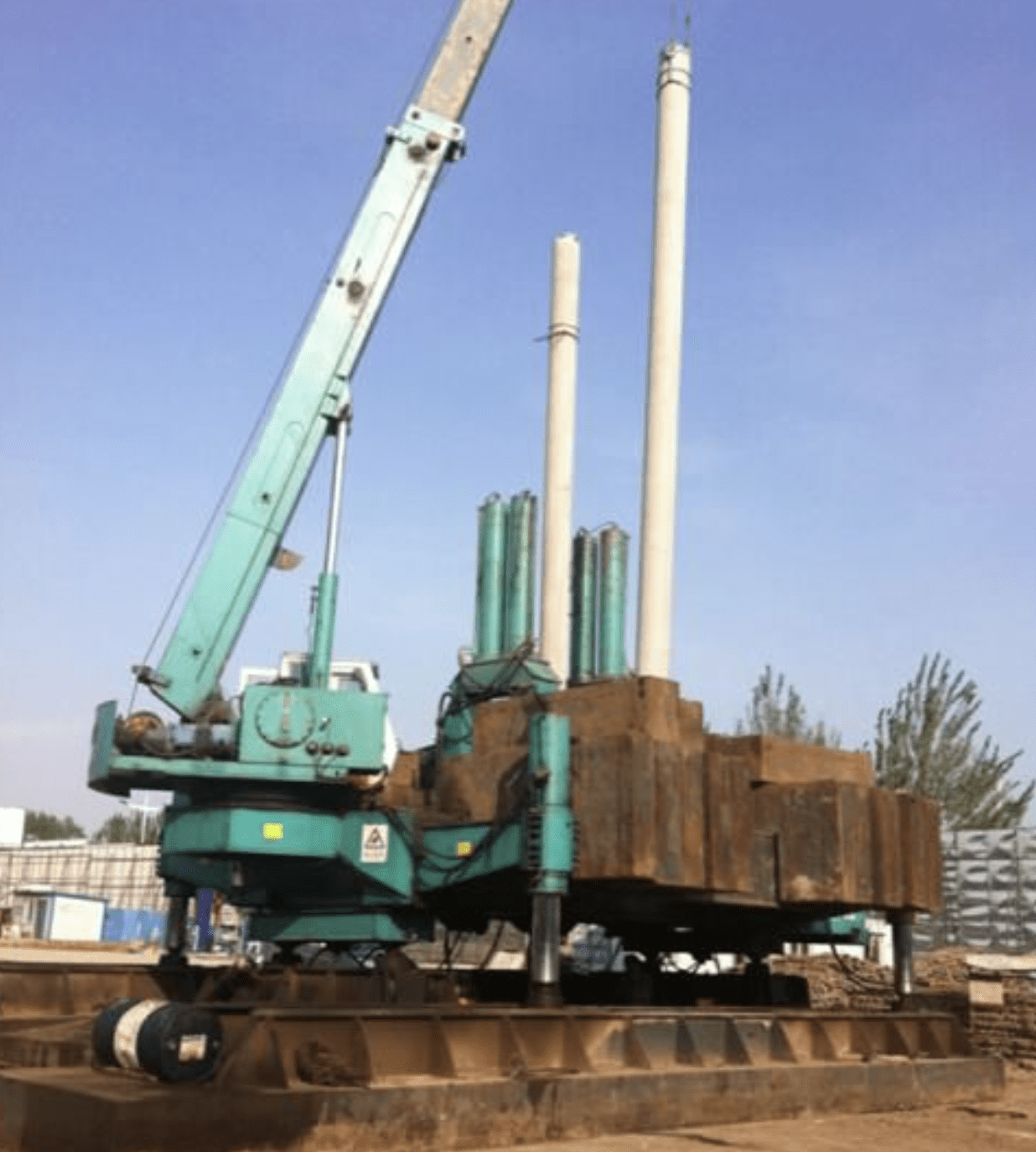Introduction
This construction technique utilizes simple equipment with strong versatility, capable of extracting precast square piles, driven cast-in-place piles, prestressed pipe piles, and certain bored piles. It offers rapid operation, high efficiency, no slurry pollution, low cost, and eliminates post-construction risks. By leveraging the dual-casing extraction advantage, it reduces the load of piles up to 30m in length and over 140 tons by more than half, lowering operational difficulty. It effectively handles inclined, broken, and pile tips in one go.
Current Common Obstruction Removal & Pile Extraction Methods
1. Full-Rotation Drilling Rig Extraction Method
This method is uniquely effective for bored piles prone to uneven diameters, such as those with collapsed walls or bulging sections. However, for extracting precast square piles, driven cast-in-place piles, or prestressed pipe piles, the equipment is prohibitively expensive, with low efficiency and high extraction costs. During extraction, the rig exerts hundreds of tons of reactive force on the ground, posing safety and quality risks if the foundation is unstable. Thus, the extraction area requires full reinforced concrete hardening.
2. Water Jetting Pile Extraction Method
This involves driving a steel pipe (larger than the old pile diameter) into the soil using a vibratory hammer, then flushing the surrounding soil into slurry with high-pressure water and air for pumping and disposal. Workers then weld a pile cap or attach a wire rope for extraction. While cost-effective and efficient, this method generates significant slurry pollution, leaving the old pile site in a muddy state, making dense backfilling impossible. In soft-soil regions (e.g., eastern China or cities along rivers), where groundwater levels are 1-2m below the surface, shield tunneling through such slurry-filled shafts can lead to water/mud surges, ground collapse, and building settlement or cracking.
Resonance-Free Double Casing Pipe Rapid Extraction Method
1. Applicable Scope
-
Pile Types: Precast square piles, driven cast-in-place piles, prestressed pipe piles, and some bored piles.
-
Soil Conditions: All soil types except thick gravel layers containing boulders.
2. Advantages
-
Higher speed than other extraction methods.
-
Lower cost and no slurry pollution.
-
The outer casing remains as a protective sleeve, backfilled with low-grade cement-mixed soil to ensure dense, watertight filling, allowing shield machines to pass through easily.
-
Efficiency:
-
For piles <20m: Over 6 piles per shift.
-
For piles >20m: Over 4 piles per day.
-
-
Handles inclined, broken piles, and pile tips comprehensively.
3. Working Principle
A resonance-free electric vibratory hammer drives dual casings (larger than the old pile diameter) into the soil. The casing length matches or exceeds the pile by 1m, with a 1-2cm gap between inner and outer pipes. During sinking, soil plugs (0.5-1.5m high, varying by soil type) block the gap at the pipe base, while the rest remains empty. When statically lifting the inner pipe, only the soil plug’s friction resists, reducing the load to the hammer, clamp, inner pipe, and contained pile/soil, cutting the lifting weight by over 50%. After extraction, the vibratory hammer discharges the old pile and soil.
4. Key Features
-
EP Resonance-Free Vibratory Hammer:
-
China’s only electric hammer operable via crane without resonance.
-
Awarded the Ministry of Construction’s First Prize for Technological Progress and listed as a promoted innovation.
-
Certified by Japan’s Ministry of Construction (now MLIT) for its hydraulic eccentric control, enabling:
-
Zero-start/stop.
-
Adjustable eccentric torque from zero to max.
-
-
-
1-2cm Pipe Gap: Minimizes lifting weight via partial soil plugging.
-
Inclined Pile Adaptation: The hammer, clamp, and pipes follow the tilt via a locator.
-
Equipment Flexibility: Compatible with cranes, crawler cranes, and pile frames.
-
Eco-Friendly Backfill: Steel pipe sleeves allow low-strength cement-soil backfilling (using waste slurry mixed with 3% 425-grade cement), ensuring dense, impermeable filling that eases shield tunneling and cuts follow-up costs.
5. Construction Steps
-
Expose Pile Head: Remove hard crust, clear the head, and measure tilt.
-
Hoist Dual Casings: Use a crane to suspend the resonance-free hammer and clamp, driving the casings into the soil.
-
Sink Casings: Repeat with vibratory force.
-
Extract Inner Pipe & Discharge Pile: Switch clamps, statically lift the inner pipe, then activate the hammer to eject the pile/soil.
-
Backfill Cement-Soil: Pump low-strength slurry mixed with debris into the casing.
Case Study: Jiaxing Project
Objective: Extract 16 m-long Φ377 driven cast-in-place pile,s including tips—a challenge that caused two teams to quit.
Soil Layers:
-
Fill (1.3m)
-
Clay (1m, soft)
-
Silt-muddy clay (2m, flowable)
-
Clay (3.8m, soft)
-
Muddy clay (9m, flowable)
-
Silty clay (4.3m, slightly dense)
Process:
-
Hoist dual casings.
-
Loosen surface crust.
-
Sink casings with the vibratory hammer.
-
Statistically extract the inner pipe.
-
Discharge plain concrete pile and soil.
-
Remove the upper reinforced concrete pile segment and the surrounding soil.
-
Extract the pile tip.


